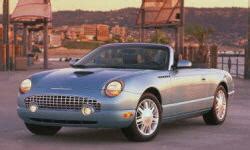
2002 Ford Thunderbird Problems: A Comprehensive Analysis
The 2002 Ford Thunderbird was a highly anticipated vehicle, marking the return of the iconic nameplate after a decade-long hiatus. However, the revival was short-lived, as production ceased in 2005 due to poor sales. While the Thunderbird offered a stylish design and a comfortable ride, it was plagued by numerous problems that ultimately led to its demise.
Engine Issues: A Persistent Headache
The 2002 Thunderbird was powered by a 3.9-liter V8 engine, which was known for its reliability and durability. However, several common issues could lead to costly repairs.
- Intake Manifold Gasket Failure: The intake manifold gasket was prone to failure, causing coolant and oil leaks. This issue could lead to overheating and engine damage if not addressed promptly.
- Spark Plug Failure: The spark plugs in the 2002 Thunderbird were known to wear out prematurely, resulting in misfires and reduced engine performance. Regular maintenance and replacement were necessary to prevent these issues.
- Timing Chain Tensioner Failure: The timing chain tensioner could fail, causing the timing chain to skip and potentially leading to catastrophic engine damage. This issue was particularly prevalent in high-mileage vehicles.
Transmission Troubles: A Frustrating Experience
The 2002 Thunderbird was equipped with a 5-speed automatic transmission, which was generally reliable. However, some common problems could cause shifting issues and reduced drivability.
- Shift Solenoid Failure: The shift solenoids, responsible for controlling gear changes, could fail, leading to harsh shifting, slipping gears, and even complete transmission failure.
- Torque Converter Problems: The torque converter, which helps transmit power from the engine to the transmission, could develop issues, causing shuddering, slipping, and overheating.
- Transmission Fluid Leaks: Leaks in the transmission fluid lines or seals could lead to low fluid levels, causing overheating and premature wear of transmission components.
Suspension and Steering Concerns: A Safety Hazard
The 2002 Thunderbird's suspension and steering systems were generally reliable, but a few issues could compromise safety and handling.
- Control Arm Bushing Failure: The control arm bushings, which connect the suspension components to the chassis, could wear out prematurely, leading to poor handling, excessive tire wear, and reduced stability.
- Rack and Pinion Steering Leaks: Leaks in the rack and pinion steering system could cause a loss of power steering fluid, resulting in decreased steering responsiveness and increased steering effort.
- Sway Bar Link Failure: The sway bar links, which help stabilize the vehicle during cornering, could fail, leading to excessive body roll and reduced handling.
Electrical Gremlins: A Source of Frustration
The 2002 Thunderbird was equipped with a complex electrical system, which was prone to a variety of glitches and malfunctions.
- Battery Drain: The Thunderbird's electrical system could suffer from parasitic battery drain, caused by faulty components or accessories that continued to draw power even when the vehicle was turned off.
- Instrument Cluster Issues: The instrument cluster, which displays vital vehicle information, could experience malfunctions, such as flickering gauges, inaccurate readings, or complete failure.
- Power Window Problems: The power window switches or motors could fail, causing the windows to become inoperable or operate erratically.
Interior Quality Concerns: A Disappointment
While the 2002 Thunderbird boasted a stylish exterior, its interior quality left much to be desired.
- Cheap Materials: The interior of the Thunderbird was filled with cheap plastics and low-quality materials, which could easily scratch or break. This resulted in a less than luxurious feel, especially considering the vehicle's price tag.
- Poor Fit and Finish: The fit and finish of the interior panels and components were often sloppy, with gaps and misalignments visible throughout the cabin.
- Squeaks and Rattles: The Thunderbird's interior was prone to squeaks and rattles, especially over rough roads or when driving with the top down.
Conclusion: A Disappointing Revival
The 2002 Ford Thunderbird had the potential to be a successful revival of an iconic nameplate. However, its numerous problems, ranging from engine and transmission issues to suspension concerns and electrical gremlins, ultimately led to its downfall.
While some of these problems were relatively minor and could be addressed with routine maintenance and repairs, others were more